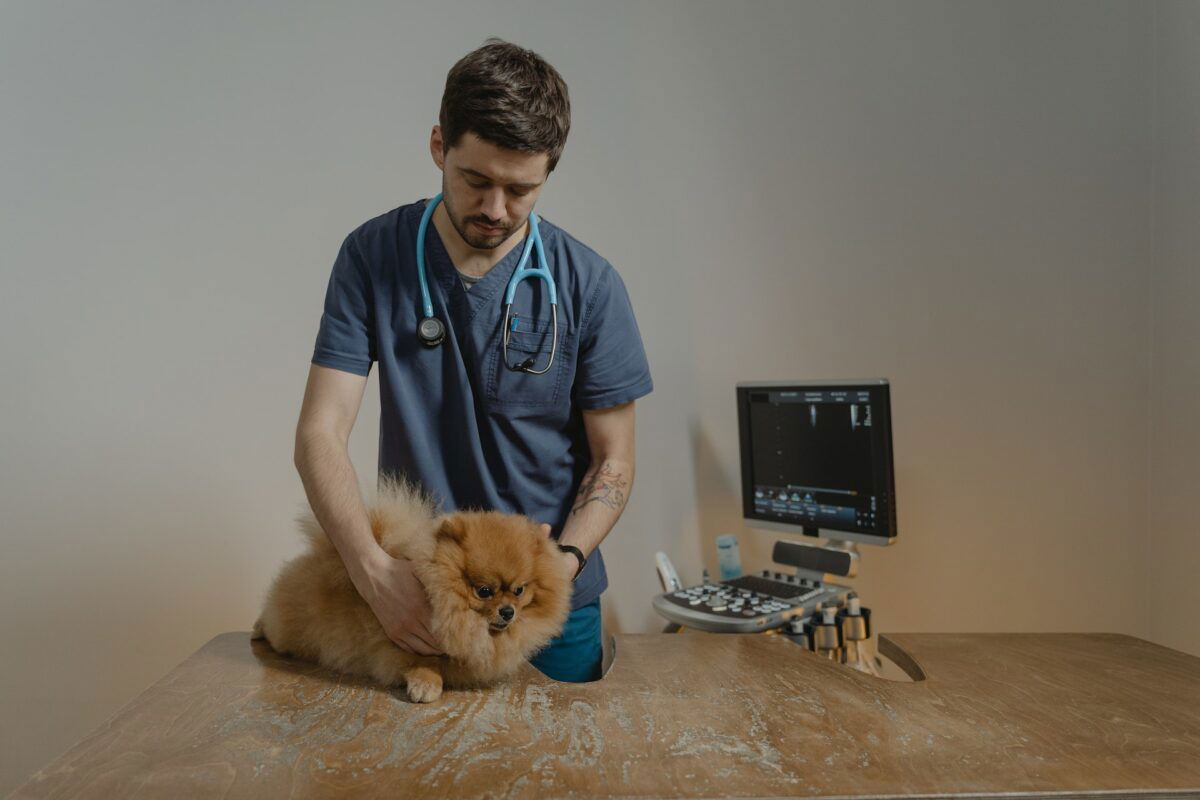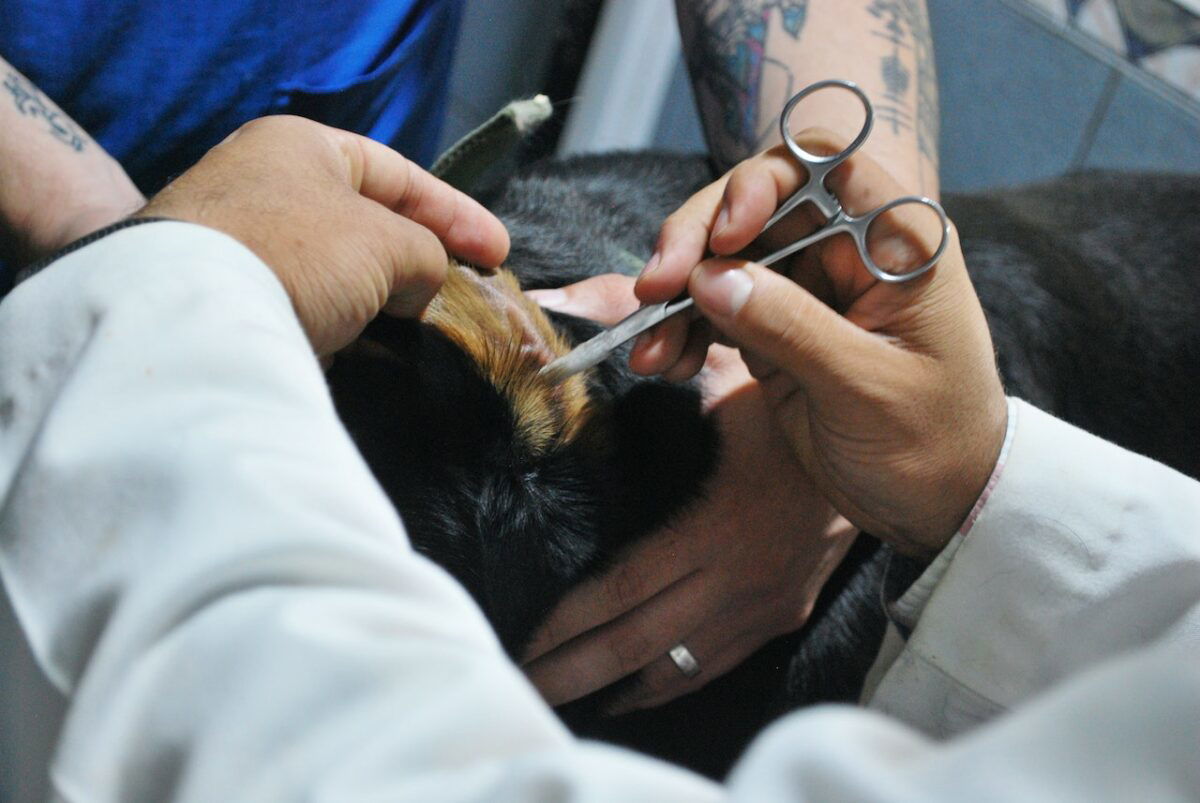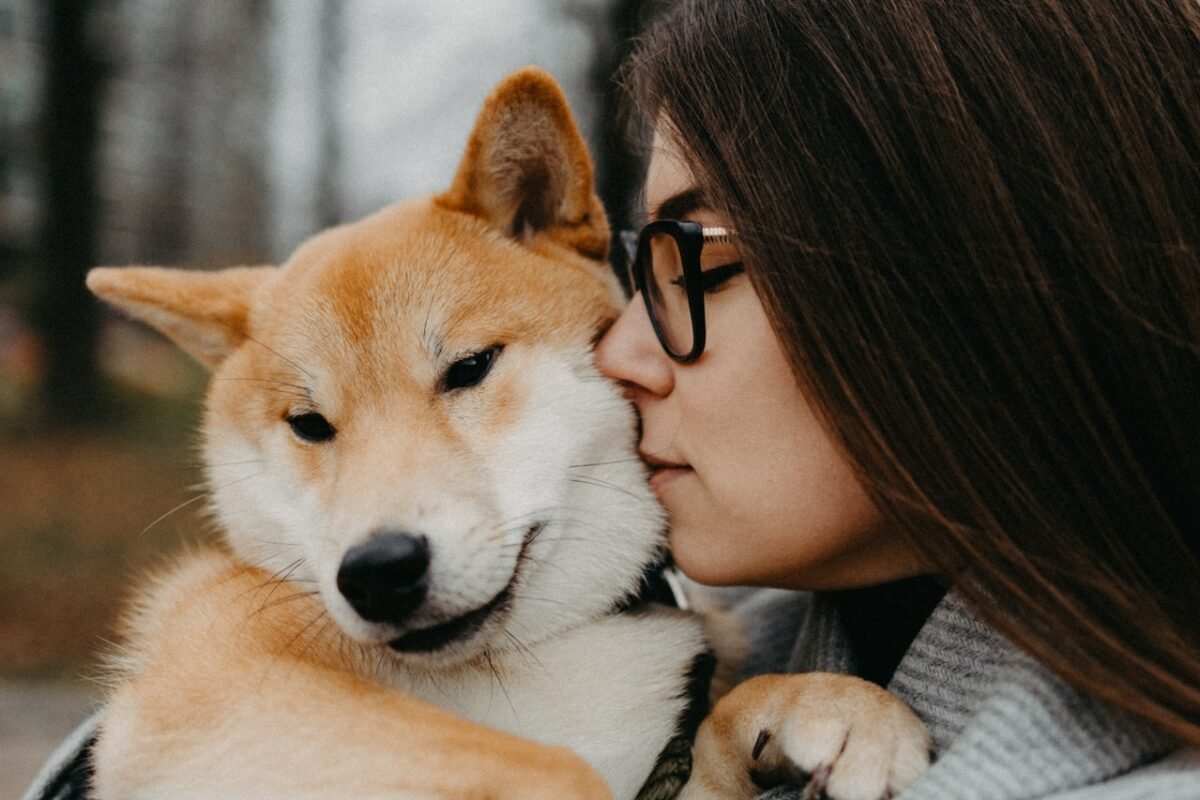We're an affiliate
We hope you love the products we recommend! Just so you know, we may collect a share of sales or other compensation from the links on this page at no additional cost to you. Thank you if you use our links, we really appreciate it!
A strong metallic smell in dogs should be a cause for concern, and sometimes it can be indicative of a serious internal health problem.
Some pet parents may assume that the iron-like smell from their beloved pup is because of snuggling on metallic appliances, but this is not always the case.
Continue reading this post to discover the reasons why your dog smells like metal, when to seek veterinarian assistance, and how to prevent it.
Why Does My Dog Smell Like Metal?
1. Natural odor variation
Different dogs, just like other animals, have distinctive smells that can be influenced by various factors such as breed, season, and environment.
Although rare, it is possible that your dog may have a faint distinctive metal-like smell due to their feeding habits and sweat.
2. Ear Infections
The onset of an ear infection may cause some strange body odor on your beloved pup, thanks to the bacteria or yeast.
Some of the other common symptoms of ear infections in dogs include excessive head-shaking, ear-scratching, redness, swelling, and odorful discharge from the ear canal.
The buildup of bacteria and yeast in the dog’s ear can lead to an infection. These pathogens may release byproducts that produce the typical metallic scent in affected dogs.
The foul odor can worsen and become more pronounced if the infections grow inside the inner ear.
3. Skin infections
Just like infections in the ear, skin infections can result in a metal-like odor in dogs including other strange scents.
The exact scent resulting from an infection on the skin is largely dependent on the type of infection some of which include bacteria, ringworms, or fungi.
The microbes causing skin infections in dogs can release specific substances that create a metallic odor.
4. Anal gland issues
Anal glands are two oval-shaped scent sacs located at the rear end in dogs, responsible for emitting small amounts of fluid which help mark territories and communicate with each other.
The fluid emitted from the anal sacs during bowel movements has a characteristic fishy smell or metallic odor in dogs.
Sometimes an anal sac issue may arise when they become impacted or do not eliminate all the fluid, resulting in a pungent odor.
In most cases, the anal gland secretions may gain a distinctive iron-like odor when it thickens in the impacted sacs.
5. Dietary factors
Low-quality dog food can cause damage to your dog’s gastrointestinal tract and result in bad odor due to imbalanced gut flora.
These may cause the dog to produce foul sweat with an iron-like odor on the paw pads or the dog’s nose.
Bad food can also contribute to your dog’s allergies and can cause yeast infections which end up leading to a bad smell.
When To Seek Veterinary Advice for The Metal Smell
While occasional strange odors are a normal part of being a dog owner, it is important to know when the metallic whiff warrants veterinary attention.
We suggest reaching out to your vet if the iron-like tang is persistent, intense, or accompanied by other concerning symptoms such as excessive scratching, redness, swelling, or discharge.

The vet will assess your dog’s overall health, work out the possible causes for the strange odor, and provide timely solutions.
Booking an early appointment with your vet is crucial for the appropriate diagnosis of potential health complications affecting your dog and also helps in prompt treatment.
How is the Metallic Odor in Dogs Diagnosed?
In order to understand the exact causes of metallic scents in your dog, your vet will perform a series of diagnostic tests.
The following section highlights a systematic approach typically used by most veterinarians to diagnose this problem.
1. Veterinary examination and history-taking
Once you make your way into the vet’s office, they will start by looking at your dog’s medical history and treatments.
It’s for this reason that you should always carry your dog’s health records book when taking them to the vet.
After looking at the dog’s medical history, the vet will proceed to conduct a thorough physical examination by looking at the ears, skin, paws, and anal glands.
It’s during this step that the veterinarian may inquire about your dog’s recent changes in behavior and eating habits.
2. Diagnostic tests for ear and skin infections
Ear infections
In addition to conducting a physical checkup of the head, the vet may also carry out an otoscopic examination to detect unusual substances.
Ear swabs may also be taken to the laboratory to identify the presence of bacteria, yeast, or fungal infections.
Skin infections
Your vet will proceed to collect samples from the skin by gently scrapping on the dog’s skin using a scalpel blade.
The collected samples are then examined under a microscope to reveal the presence of mites, bacteria, fungi, yeast, and other microorganisms.
Sometimes the vet may do a full blood work to investigate the underlying causes of skin infections in dogs.
Some canine skin conditions are solely a result of internal diseases, for example, demodicosis can develop due to Cushing’s disease.
3. Anal gland assessment and expression
If the metal-like tang is concentrated on your dog’s rear end, your vet will suspect anal gland issues as the main cause of the problem.
After the assessment, a vet technician will manually express the anal glands by reaching inside the rectum with gloved fingers and gently compressing the sacs to release content.
Your vet will carefully observe the expressed content by color, smell, and consistency to tell if everything is normal.
The typical smell of anal gland content is usually fishy and the normal color is muddy brown.
4. Evaluating the diet and nutrition of the dog
Your vet will ask about your dog’s previous food consumption and regular diet to evaluate their overall nutritional intake and allergies.
Make sure to provide the vet with information such as the type of foods taken by your dog, the portion sizes, and recent changes made in the diet.
Your vet will assess the dog’s feeding history and determine whether they’re receiving a healthy diet for their overall health, especially for coat and skin health.
How To Treat Metallic Smell in Dogs
A. Addressing underlying health issues
1) Treating ear infections
If your dog is diagnosed with inner ear infections, the vet may prescribe medicated ear drops or ointments depending on the severity of the condition.

A topical medication is usually used in most cases to deal with bacterial or yeast infections in the ear.
Anti-inflammatory medicines, antifungal drugs, or oral antibiotics may be prescribed in case of severe infections.
2) Managing skin infections
The treatment of skin infections in dogs can vary depending on the exact cause and severity of the condition.
For bacterial skin infections, your vet will administer antibacterial skin drugs to combat the growth of pathogens on the coat.
If your dog was diagnosed with an internal condition affecting the skin, the vet will first deal with the underlying cause as they manage the dermal condition.
In order to manage the healing process, you may have to clean your dog with antibacterial soap or medicated shampoo to kill bacteria and for itch relief.
3) Anal gland expression or treatment
If the metallic whiff on your dog is caused by an impacted anal gland or related issues, your vet may have to manually express the content or provide treatment.
This procedure is typically done by a vet technician who reaches out to the sacs with a gloved hand and empties the content manually to relieve the impaction.
For severe cases affecting the anal glands, your vet may recommend surgery to address any chronic issues or infections.
B. Dietary adjustment and supplements
In some cases, you may have to adjust your dog’s dietary plan and incorporate certain supplements in their diet for their overall health.
Your vet nutritionist will help you work out a simple meal plan for your dog that includes a balanced mix of all essential nutrients.
Avoid offering your dog low-quality meals, instead go for high-quality canine foods including modest amounts of dog-safe fruits and vegetables.
A tiny taste of dog-friendly fresh fruits and vegetables can help neutralize foul odor in your canine friend.
It’s important to include foods rich in omega-3 fatty acids for the benefit of your dog’s skin health and to keep their coat soft and shiny.
You can also supplement your dog’s diet to boost their nutritional uptake without necessarily adding too many calories.
Make sure to talk to your vet before adding new foods to your dog including supplements. It also helps to monitor your dog’s reaction to specific foods to look out for negative reactions.
How To Prevent Metallic Odors in Dogs
1. Proper ear and skin care
As a responsible dog owner, you need to regularly inspect your dog’s ear and skin to check for the presence of foreign substances.
You can use a vet-approved ear-cleaning solution and a smooth cotton wool ball to wipe down your dog’s ear to remove dirt and pathogens.
2. Diet and nutrition recommendation
Offer your dog a balanced diet with a nice touch of all essential nutrients and minerals. Puppies should be given more proteins to help them in building strong muscles and tissues.
A nutrient-rich diet can help your dog improve their overall health and strengthen their immune system to combat infections or infectious diseases.
Your dog’s diet is never complete without a serving of clean drinking water. Make sure to set up various water points across your home to keep your furry friend hydrated.
3. Regular grooming and bathing
Get a good dog brush and glide through your pup’s coat daily or at least a few times a week to remove matted fur and debris from the coat.
Brushing your pup regularly also helps distribute the natural oils on the skin to keep the coat looking glossy and fluffy.
Grooming your dog routinely also provides a perfect opportunity to strengthen your bond and inspect them for flea infestation.
While stroking your dog’s coat, it’s important to look for external parasites, reddened skin, hotspots, lumps, and rashes across the entire body.
Chat with your vet once you notice any abnormal conditions on your pup’s body before it grows to make them uncomfortable.

In addition to regular grooming, you should bathe your dog at least once every month to minimize body odor and prevent oil buildup.
The bathing frequency can vary from dog to dog depending on their coat type, level of activity, skin conditions, and breed.
Active dogs with medium or long coats should be bathed every month or biweekly, while short-coated dogs can do with a six-week window before taking another shower.
Make sure to use a dog-specific shampoo and warm water when bathing your dog to care for their skin and make them comfortable during the session.
Be careful not to over-bathe your dog, because doing so may strip off the natural oils from the skin, causing more problems.
We suggest booking an appointment at a pet salon every six months or yearly for a round of professional grooming to keep your dog’s coat in optimal condition.
4. Preventive veterinary check-ups
Taking your dog to the vet for regular wellness checks is crucial for their overall internal health and well-being.
Doing so will enable the vet to monitor your dog and detect potential health issues early enough to avoid serious illness.
It’s during these routine checkups that your dog should be given their yearly booster shots for preventing communicable diseases and strengthening their immunity.
Frequently Asked Questions (FAQs)
1. Why does my dog smell like iron?
An iron-like whiff in dogs can be indicative of serious problems including ear infections, impacted anal glands, low-quality diet, or skin diseases.
You can check for supplementary symptoms to narrow down to the exact cause of your dog’s strange odor.
If your dog is scratching the ear while shaking the head, you can suspect an ear infection as the cause, while redness on the skin can be a sign of skin issues.
A strong metallic sniff from the rear end of your dog may be an indicator that the anal glands are full and they need to be expressed manually.
2. Is it normal for a dog’s paws to have a metallic odor?
A mild metal-like odor on any of your dog’s paws can be normal because they make contact with different surfaces while walking or playing outdoors.
However, a strong or persistent metallic odor on the paws should be a cause for worry because it may indicate underlying issues such as bacterial or fungal infections.
A low-quality diet could also make the dog’s merocrine glands located on the paw pads to excrete metal-smelling sweat.
If you suspect the metal odor from your dog’s paws is beyond the normal range, you should seek further guidance from the vet.
Closing Thoughts – Why does my dog smell like metal?
Pungent metallic odor in dogs should not be taken lightly since it can point to issues such as ear infections, skin diseases, anal gland issues, dietary concerns, or internal health disorders.
You should take your dog to the vet for a checkup once you detect a strong iron-like scent from any part of their body.
Look out for other symptoms such as lethargy, excessive scratching, head-shaking, biting, or loss of appetite to narrow down to a specific cause.
We suggest cleaning your dog’s ears with medicated solutions, grooming them regularly, and bathing as your vet advises to keep their skin in excellent condition.
Make sure to provide a high-quality balanced diet to your dog to support their overall health and to prevent impacting the anal glands.
Metallic smell in dogs can be annoying, but with the preventive measures you can be a step ahead to keep your dog’s scent in check.
Laura is the founder of Furs'n'Paws. She is a also a pet writer and expert with more than 20 years of experience of working with dogs and cats. She developed a very strong love for animals at a young age. Her passion led her to establish a thriving pet sitting and dog walking business in Dubai. As an expert in pet training, behavior, and nutrition, Laura is committed to helping pet owners and pet lovers by offering high-quality information on a wide range of topics.



No responses yet